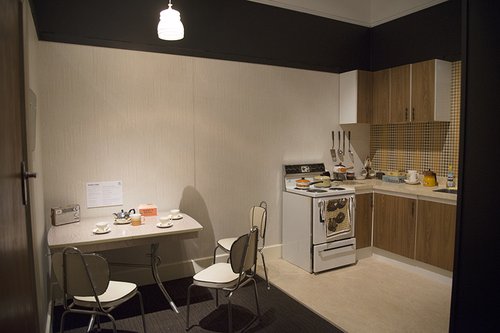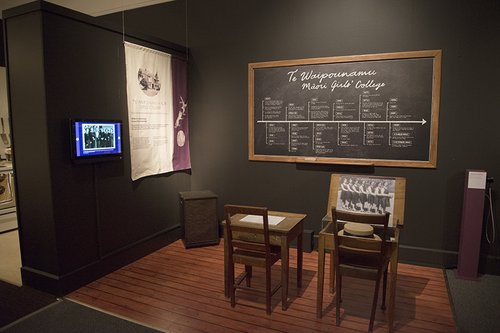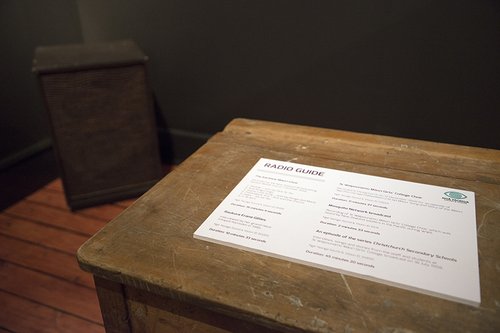
By Sarah Johnston
The exhibition is enriched by sound recordings from the radio collection of Ngā Taonga Sound & Vision.
Hero image: Installation in 'Hākui: Women of Kāi Tahu' at the Otago Museum.

Installation in 'Hākui: Women of Kāi Tahu' at the Otago Museum.
Hākui: Women of Kāi Tahu was developed over two years by the museum in close partnership with whānau and papatipu rūnaka around the South Island.
The exhibition opened on November 20 to coincide with the biennial Hui-ā-Iwi gathering that saw over 2,000 iwi members arrive in Dunedin for the weekend celebration of Kāi Tahutanga.
The term hākui is an acknowledgement of respect and a form of address to a female elder, and this exhibition celebrates mothers, aunties, grandmothers, taua, great aunts, great grandmothers, and tūpuna wāhine.
Fifty women are profiled in the exhibition, and their accomplishments shared through taoka*, photographs, memories and sound recordings. Interactive elements also feature, inviting visitors to step inside Aunty’s kitchen, hear the pronunciation of Māori words and placenames, and plenty more.

Migoto Eria (Ngāti Pāhauwera, Ngāti Kahungunu), Curator, Māori at the Otago Museum - listening to one of the archival sound recordings from Ngā Taonga Sound & Vision.
Migoto Eria (Ngāti Pāhauwera, Ngāti Kahungunu), Curator, Māori at the Otago Museum, says the process of deciding which of the women to focus on was led by the iwi, with a steering committee representing local rūnaka set up in 2013:
“The hākui featured in this exhibition have facilitated the growth and nourishment of their mokopuna; they have protected and shared their knowledge; and they have provided vital guidance and support to their iwi,” she says. “So it has been an honour to work closely with whānau and rūnaka on this important kaupapa.”
Last year Migoto contacted us at Ngā Taonga Sound & Vision’s radio collection in Christchurch, to see what sound recordings we might hold relating to these wāhine.
We discovered quite a few of the kuia had been recorded over the years, in interviews and other recordings. Some are held in our Ngā Taonga Kōrero Māori radio collection, and others in our historic general collection, dating back to the 1940s.
They range from public figures like the late politician Whetū Tirakātene-Sullivan and pioneering Māori broadcaster Airini Grennell, to musicians such as Wiki Baker, and community activists like Magda Wallscott – who helped lead opposition to the Aramoana aluminium smelter in the 1980s.

Installation in 'Hākui: Women of Kāi Tahu' at the Otago Museum.
A highlight was rediscovering the sound recordings by and about Te Waipounamu Māori Girls’ College, which was the South Island’s only Māori girls boarding school. Many of the women in the exhibition were old girls of Te Waipounamu, which is still remembered very fondly for its musical and cultural prowess. (The Christchurch school closed in 1990.)
A corner of the exhibition focuses on the school. Visitors can listen to excerpts of this concert by the girls, recorded in 1945 for a broadcast to New Zealand soldiers serving in the Pacific during World War II:
Excerpt of a concert by the girls at Te Waipounamu Māori Girls’ College - recorded in 1945 for a broadcast to New Zealand soldiers serving in the Pacific during World War II. (Ngā Taonga Sound & Vision Radio Collection, all rights reserved. To enquire about re-use of this item please contact us)

Installation in 'Hākui: Women of Kāi Tahu' at the Otago Museum.
Hākui: Women of Kāi Tahu will run at the Otago Museum until 8 May 2016, so if you are heading to Dunedin over the summer, be sure to pay a visit.
*This article uses the Kāi Tahu varaiation of “ng” – i.e. “k”: rūnaka = rūnanga, taoka = taonga, Kāi = Ngāi.